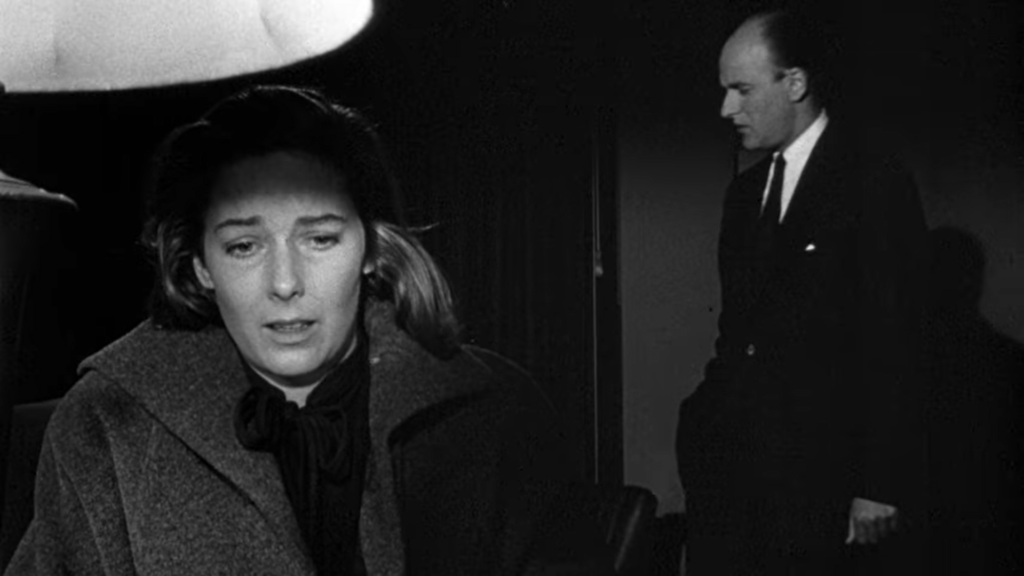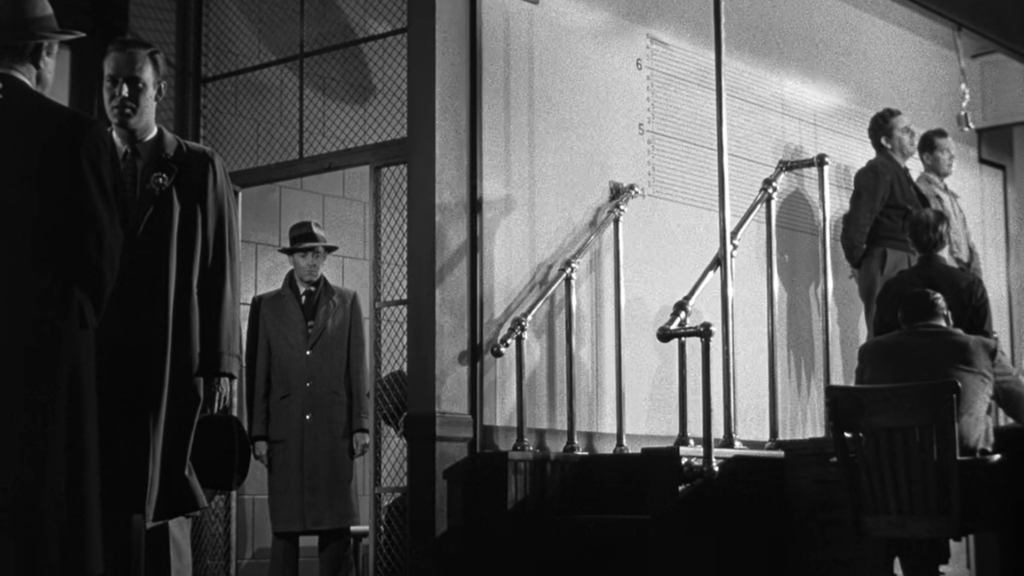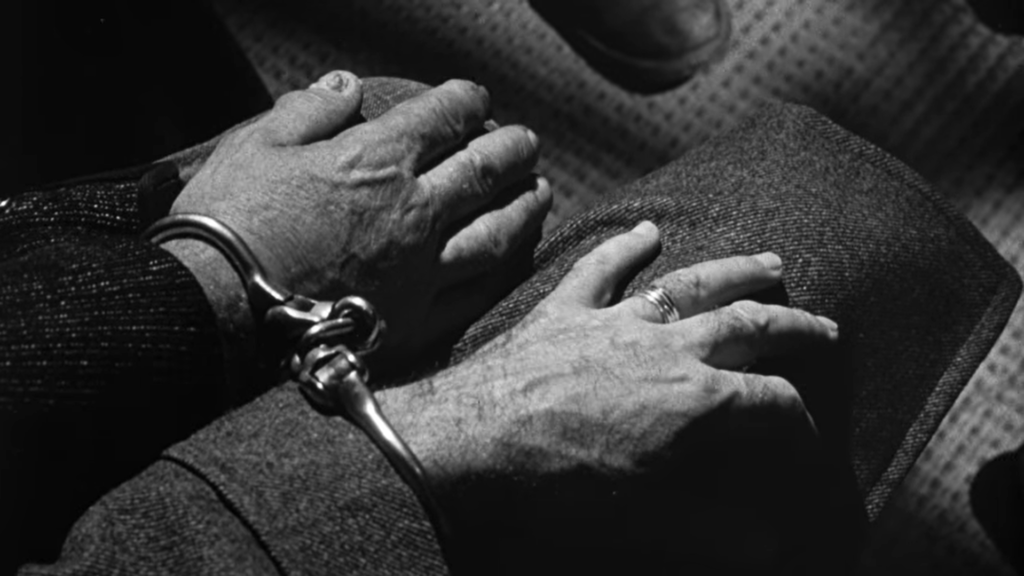| Malcolm Cooke |

The Wrong Man plays at the Trylon Cinema from Monday, April 1st, through Tuesday, April 2nd. Visit trylon.org for tickets and more information.
At the start of The Wrong Man, a darkly silhouetted Alfred Hitchcock declares this film is different from all the ones he has made before: this story is true, and he intends to tell it with clinical accuracy. Hitchcock takes this task seriously, so seriously in fact, that critic Glenn Kenny1 called it his “least fun” movie and the director himself said it “suffer(ed) from a lack of humor.”2 He casts real people and places in the roles they played in the story (the mental hospital that appears later in the film is the same one the real world Rose went to, and the doctors play themselves) as well as using unknown actors to increase the feeling of authenticity. The prison scenes were shot on location amongst real prisoners, and Henry Fonda was made to follow their routines when they found him in an empty cell.3 In fact, Hitchcock had misgivings about his obsessive attention to accuracy, saying “It’s possible I was too concerned with veracity to take sufficient dramatic license.”4 However, despite his protests, those worried that Hitchcock’s film is simply a dry retelling needn’t be concerned. It is infused with eruptions of Hitchcockian style and has a camera that skillfully expresses the inner world of its characters. The Wrong Man lies on a knife’s edge between hard reality and cinematic subjectivity.
The film begins with Christopher Emmanuel “Manny” Balestrero (Henry Fonda) walking home after a credits sequence in the high-class Stork Club where he plays as a bassist. As Manny descends into the subway two beat cops appear, quite literally “framing” Manny in the shot, foreshadowing the threatening and oppressive presence of the police in the story from this point forward. On the train, Manny flips through a newspaper, a seemingly mundane sequence that Jean-Luc Goddard adulated in his lengthy piece of criticism on the film as an example of how “Throughout his entire career, Hitchcock has never used an unnecessary shot.”5 His smiling response to a family-oriented ad for cars establishes Manny as a devoted family man. Likewise, an insurance ad gives him the idea to take a loan on his wife’s policy in the following scene, which sets the plot in motion. Furthermore, the audience sees Manny’s one vice, annotating the results of horse races published in the paper. Manny only occasionally places actual bets, maintaining his integrity, and prefers to make imaginary bets, seeing how much he would have won or lost as opposed to actually gambling. This gives Manny some personality, while also efficiently exposits his money troubles as well as the themes of chance, risk, and circumstance which are all about to become much more prevalent.

As Godard remarks, many seemingly innocuous elements of the film have a double meaning. To Godard, the film is filled with doubles. To him, each important scene has a double; a negative version which, “justifies it on a narrative level while at the same time ‘redoubling’ its intensity on the dramatic level.”6 The following scene is one of these. Manny returns home and has an affectionate conversation with his wife Rose (Vera Miles). Much later in the film the same scene is replayed but instead, their interactions are filled with malice and paranoia. Manny returns home to find Rose in bed as before, but this time Rose is in the throes of a mental breakdown, wracked with guilt and neurosis due to Manny’s impending incarceration. What is the first time around a series of intimate close-ups is reimagined as a scene where Manny and Rose are distant from each other, emotionally and physically, casting long and ominous shadows on the walls. Eventually, the scene erupts in a masterful series of shots where Rose hits Manny on the head with a brush. But for now, the Balestrero home with its tight hallway and small rooms is cozy instead of claustrophobic.
But quickly the tension of the story begins to creep in, in part through the copious use of perspective and POV shots. In the following scene, Manny heads to an insurance office to take out a loan on his wife’s policy, leading to a series of tight, tense shots that place viewers in the perspective of the various office workers, as they peek apprehensively at Manny who they mistake for a man who previously robbed the office. The camerawork fills the scene with such paranoia and tension, that Martin Scorsese drew on it as an inspiration for Taxi Driver.7 POV shots are used to great effect later, occupying the subjective perspective of Manny as he enters the cold and fast-moving world of the criminal justice system. While being driven to the police station, the audience looks through Manny’s eyes at the menacing detectives to his left and right, and the accusing eyes of the driver in his rearview mirror. When sent to prison and chained to another prisoner Manny keeps his head bowed in shame; we see no faces, but only shots of pants and shoes. Fonda looks perpetually awkward and out of place in these spaces, following the orders of the detectives silently and with little protest, all the while being bombarded ad nauseam with the increasingly ironic statement, “an innocent man has nothing to fear.” As he has his mugshot taken, appears at a hearing, and has his bail set, it is repeatedly affirmed that Manny doesn’t belong here. He’s a good and reliable man who takes care of his mother, is never late coming home, and presumably stops to feed and pet every stray cat on the street. Meanwhile little attention is given to the other convicts who silently fill the backdrop of these scenes. Whereas the perspective shots center the world and emotions of Manny, the camera is indifferent towards the other prisoners, who loiter on the edges of the frame and whose faces are hidden from us as Manny inspects their hands and shoes. We are given an easy and simple tale of injustice: a respectable man is mistakenly thrown into the uncaring jaws of prison. But little thought is given to the consequences of this system when everything is going according to plan.

In the second half of the film following Manny’s descent into the dark world of jail, the story loosens up a bit. Manny and Rose search for an alibi and Rose begins an accelerated descent into madness, overcome with misplaced guilt at Manny’s imprisonment. This is where Hitchcock himself said that the film’s dedication to maintaining the original story “resulted in some deficiencies in the film’s construction.”8 Although Rose’s madness might seem to strain credulity as a decidedly Hitchcockian psychological twist, her breakdown is actually true to life. In Hitchcock’s opinion, the focus on Rose distracted from the main tension of Manny’s accusation, turning the trial into an anticlimax by the time it arrived. Further small details like the trial ending abruptly in a mistrial, and the actual perpetrator being found before it started again added to the apparent lack of dramatic weight. But despite an adherence to the story’s veracity, Hitchcock still takes a large amount of stylistic license in the reveal of the actual robber, shown through a drawn-out crossfade where the thief walks into frame, his face overlaying Manny’s like a double exposure. This revelation appearing as a result of a desperate Manny praying to a photo of Jesus also marks this film as one of Hitchcock’s “most catholic,”9 and the discovery of the culprit as a result of prayer is a creative element Hitchcock was particularly fond of.10
In spite of the obsession with veracity, the film ends with an extremely surreal juxtaposition of truth and Hollywood fiction. We close on a heartbreaking scene of Manny visiting Rose in a mental hospital. Despite his freedom, Rose is now seen behind barred windows. He escaped from prison at the cost of her taking his place. As Manny walks away from her room, now a broken man, the emotions are undercut by a saccharine epilogue slide explaining that Rose made a full recovery, now living happily ever after with her family. The switch is so jarring it appears it almost must be ironic. In reality, Rose never fully recovered, with money from a lawsuit against the state as well as rights to the movie going to pay for loans covering her treatment.11 As the film leaves the audience with this dissonant feeling, you can’t help but ask yourself how much of the real Rose’s struggle is caught in Hitchcock’s portrayal. Hitchcock preaches veracity and yet his style overtakes the film, filling it with the dreamy and subjective language of cinema. It is a world where we see through Manny’s eyes and his prayers come true. So is The Wrong Man a dry documentary account or something stylized and subjective, like an unreliable memory that changes with each retelling? As Godard writes, ending his own piece on The Wrong Man discussing the same epilogue, “Draw your own conclusions.”12
Footnotes
1 Glenn Kenny, “‘The Wrong Man’: Hitchcock’s Least ‘Fun; Movie Is Also One Of His Greatest” RogerEbert.com, February 17, 2016, https://www.rogerebert.com/features/the-wrong-man-hitchcocks-least-fun-movie-is-also-one-of-his-greatest
2 Truffaut, François. Hitchcock. Simon and Schuster, 1983. Pg 202.
3 Truffaut, François. Hitchcock. Simon and Schuster, 1983. Pg 237.
4 Truffaut, François. Hitchcock. Simon and Schuster, 1983. Pg 240.
5 Narboni, Jean, and Tom Milne. Godard on Godard. Da Capo Press, 1972. Pg 48.
6 Narboni, Jean, and Tom Milne. Godard on Godard. Da Capo Press, 1972. Pg 53.
7 Christie, Ian, and David Thompson. Scorsese on Scorsese. Faber and Faber, 2003. Pg 60.
8 Truffaut, François. Hitchcock. Simon and Schuster, 1983. Pg 239-240.
9 Kenny, ‘The Wrong Man’: Hitchcock’s Least ‘Fun; Movie Is Also One Of His Greatest”.
10 Truffaut, François. Hitchcock. Simon and Schuster, 1983. Pg 243.
11 Lou Lumenick, “A case of mistaken identity ruined this man’s life — and inspired Hitchcock” New York Post, February 7, 2016, https://nypost.com/2016/02/07/a-case-of-mistaken-identity-ruined-this-mans-life-and-inspired-hitchcock/
12 Narboni, Jean, and Tom Milne. Godard on Godard. Da Capo Press, 1972. Pg 55.
Edited by Finn Odum
